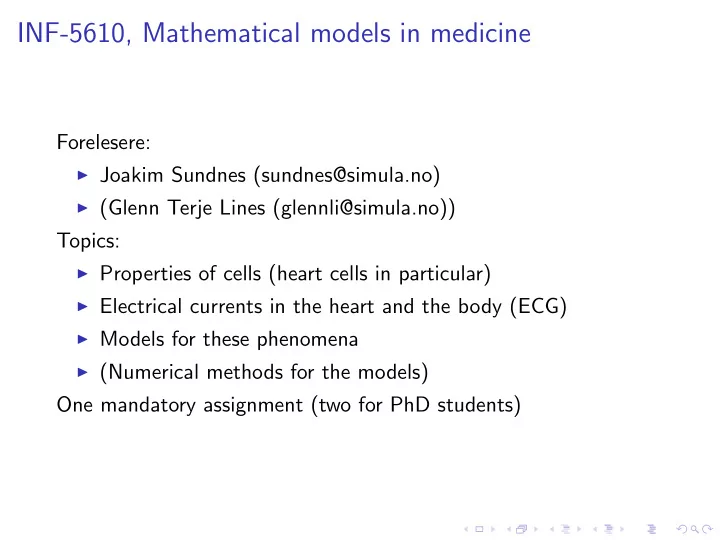

INF-5610, Mathematical models in medicine Forelesere: ◮ Joakim Sundnes (sundnes@simula.no) ◮ (Glenn Terje Lines (glennli@simula.no)) Topics: ◮ Properties of cells (heart cells in particular) ◮ Electrical currents in the heart and the body (ECG) ◮ Models for these phenomena ◮ (Numerical methods for the models) One mandatory assignment (two for PhD students)
Literature J. Keener and J. Sneyd, Mathematical Physiology, second edition (two volumes)
Oral exam ◮ Six topics are given, no later than two weeks before the exam ◮ You prepare a 20 min lecture on each topic ◮ In the exam you draw one topic, and give a lecture on this ◮ Questions will be asked from the other topics
Lecture plan, part I ◮ Anatomy, about cells and the heart. Keener & Sneyd (KS) ◮ Fundamental biophysical processes. KS chap 2 ◮ Ion channels KS. chap 3 ◮ Excitability and signal propagation. KS chap 4 ◮ Neurons and cell to cell coupling. KS chap 7& 8 ◮ Calcium dynamics. KS chap 5
Lecture plan, part II ◮ The electrocardiogram. KS chap 12. ◮ Bidomain model. KS chap 11. ◮ Muscle contraction. KS chap 15. ◮ (Circulation models. KS chap 11.) ◮ (Numerical methods)
Levels of modeling ◮ Body ◮ Organ ◮ Tissue ◮ Cell ◮ Organelles ◮ Proteins We will in this course focus mainly on the levels of cells and tissue.
The Cell Membrane ◮ Consist of a bilipid layer ◮ Embedded proteins for transport control ◮ Selectively permeable ◮ Maintains concentration gradients ◮ Has a transmembrane potential
The cell membrane (II)
Two types of transmembrane flow Passive: Diffusion along the concentration gradient ◮ Through the membrane (H 2 O , O 2 , CO 2 ) ◮ Through specialized channels (Na + , K + , Cl − ) ◮ Carrier mediated transport Active: Energy driven flow against the gradients ◮ ATP driven pumps (Na + − K + , Ca 2+ ) ◮ Exchangers driven by concentration gradients (Na + − Ca 2+ )
Cardiac propagation Cardiac cells has two properties and corresponding function ◮ Excitable → Propagates the AP ◮ Contractive → Pumps blood Furthermore, the arrival of an AP triggers contraction. Cell to cell coupling. Two types: ◮ Tight junctions: Transfer mechanical energy ◮ Gap junctions: Inter cellular channels where ions can flow
The conduction system
The path of electrical signal in the heart ◮ Originates in the sinoatrial node (sinusknuten) ◮ APs spreads throughout the atria ◮ The atria and ventricles are separated by an insulating membrane ◮ Only path of conduction through the AtrioVentricular node ◮ Slow propagation through the AV node, ◮ From the AV node the signal propagate through Purkinje fibers, which have a high conductivity ◮ These fibers end at the endocardial surface of the ventricles ◮ The arrival of AP at these endings depolarize the tissue and the wavefront spreads out from these locations. Propagation in both 1D and 3D.
Recommend
More recommend